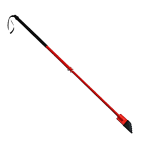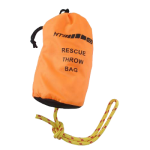It is that time of the year to talk about ice safety. I know it is eating at me to get out there too, but you don’t want an unexpected swimming lesson.

If you take some time to be smart and prepared, your trip will be a lot dryer and more comfortable.
 Take a spud. I know we have all switched to power augers but nothing beats a couple hard whacks with your ice spud to verify the thickness will support not only your weight but that of your gear as well. It can also serve as a backup to your auger or for reopening old holes.
Take a spud. I know we have all switched to power augers but nothing beats a couple hard whacks with your ice spud to verify the thickness will support not only your weight but that of your gear as well. It can also serve as a backup to your auger or for reopening old holes. Anti Slip. I wear Kahtoola Micro Spikes, but you can get a pair for $20-$80 depending on brand and quality. Not only do they help prevent falls but those near falls that seem to hurt almost as bad. Also when climbing lake side embankments and icy parking lots. I often use mine when clearing the snow and ice packed walks.
Anti Slip. I wear Kahtoola Micro Spikes, but you can get a pair for $20-$80 depending on brand and quality. Not only do they help prevent falls but those near falls that seem to hurt almost as bad. Also when climbing lake side embankments and icy parking lots. I often use mine when clearing the snow and ice packed walks. Floating Suit. I know a lot of the guys say that their old barn jacket and bibs are fine and keep them warm, but have you ever got a pair wet? They suck up water like a Shamwow!
Floating Suit. I know a lot of the guys say that their old barn jacket and bibs are fine and keep them warm, but have you ever got a pair wet? They suck up water like a Shamwow!  They get heavy, not what I want if I do go for an icy swim. Modern ice suits not only provide excellent wind and thermal protection, but they also keep you afloat. Keeping near the surface is a requirement for any kind of self rescue. And yes we have tested them in warm water to be sure.
They get heavy, not what I want if I do go for an icy swim. Modern ice suits not only provide excellent wind and thermal protection, but they also keep you afloat. Keeping near the surface is a requirement for any kind of self rescue. And yes we have tested them in warm water to be sure. Picks. If you do go through, grabbing ice with cold wet hands isn’t the easiest thing to do. A set of these picks go for less than $15 in most shops. However having them zipped up in some pocket or tucked away s not going to be as easy as running them down each sleeve and across your back. Especially on early ice I like to have them sticking out my sleeves or tucked in the cuffs. Being able to get to them quickly is an extremely important part of self rescue.
Picks. If you do go through, grabbing ice with cold wet hands isn’t the easiest thing to do. A set of these picks go for less than $15 in most shops. However having them zipped up in some pocket or tucked away s not going to be as easy as running them down each sleeve and across your back. Especially on early ice I like to have them sticking out my sleeves or tucked in the cuffs. Being able to get to them quickly is an extremely important part of self rescue. Throw Rope. When I was a kid fishing with my grandfathers, they always told me that if you had to get a guy out of the water to lay down on the ice and reach out with the auger and pull them up. Well I agree with the lay down and spread you weight out concept, but my auger is way sharper than Gramps had and it is hooked to a power drill. So without getting into the images of spinning razor sharp blades, I carry a throw rope. I made my own. Took a small nylon bag and put a grommet in the bottom. I thread a 1/4in rope through the grommet and put a knot on each side. Tuck the remainder of about 25ft of line into the bag and close the draw string. With a carabiner on each end it is an easy toss across the hole for that unfortunate buddy who is flailing his arms to grab. Of course you can go buy one too.
Throw Rope. When I was a kid fishing with my grandfathers, they always told me that if you had to get a guy out of the water to lay down on the ice and reach out with the auger and pull them up. Well I agree with the lay down and spread you weight out concept, but my auger is way sharper than Gramps had and it is hooked to a power drill. So without getting into the images of spinning razor sharp blades, I carry a throw rope. I made my own. Took a small nylon bag and put a grommet in the bottom. I thread a 1/4in rope through the grommet and put a knot on each side. Tuck the remainder of about 25ft of line into the bag and close the draw string. With a carabiner on each end it is an easy toss across the hole for that unfortunate buddy who is flailing his arms to grab. Of course you can go buy one too.- Dry Clothes. I keep a duffle in the truck all winter with fleece pants, jacket and dry socks packed for that cold day when I get surprised. Glad to say it has been almost 6 years since I learned the lesson
 that cold dry jeans don’t pull on very easy over wet legs. If it happens you will need to change, so just be ready, hypothermia can set in before you can get the truck warmed up and drive home.
that cold dry jeans don’t pull on very easy over wet legs. If it happens you will need to change, so just be ready, hypothermia can set in before you can get the truck warmed up and drive home. - Don’t Go Alone. It is always better to have someone to chat with while fishing, but if you do go in you will be looking for all the help you can get to get out. So maybe you should get your best fishing buddy a throw rope for christmas and share the link to this post.
Recently my friend Steve Kelly from Wood Radio called and said come in and talk about ice safety. So here is a link to the Facebook Live video.
Some other items I like to bring.
- Whistle
- Spare dry gloves
- Spare knit hat
- Hand warmer packs
- Snacks
- Pool Chemical Bucket with a screw top lid to keep spare gear dry.


You must be logged in to post a comment.